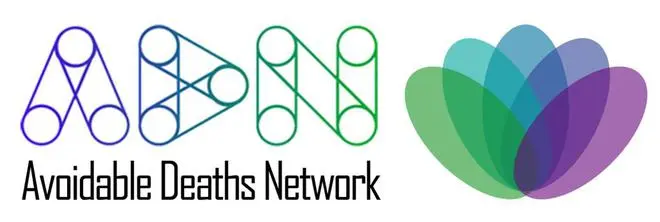High annual snakebite envenoming events in the Indian subcontinent, particularly India, which account for nearly 50 per cent of global annual snakebite deaths, will be the focus area of a global membership network working with partners in India. Snakebite envenoming results from the injection of venom, a mixture of specialised toxins of a venomous snake. A life- and limb-threatening event, it can leave a huge burden of economic debt, as well as psychological trauma to the survivor, says a paper co-authored by Nibedita S Ray-Bennett, Stephen P Samuel, and Tom Caley.
Also read: BSV, IISc to develop region-specific snakebite treatment

Logo of Avoidable Deaths Network
S Ray-Bennett is an Associate Professor in Risk Management at the UK-based University of Leicester, and also the Founding President of Avoidable Deaths Network (ADN), the global membership network dedicated to avoiding human deaths from natural and human-made disasters. In 2021, the WHO estimated 5.4 million snakebites occur globally each year, with up to 2.7 million cases of envenoming. A majority of snakebite deaths occur during the South-West monsoon (June-September), says the paper. The high burden of snakebite envenoming is on account of the large population in the subcontinent working in rural and agricultural settings with a high density of medically important snakes.
Also read: AstraZeneca expands its portfolio by bringing rare disease therapy for patients in India

Logo of CROPC
Unlike other neglected tropical diseases, snakebite deaths are avoidable. The ADN advocates preventable, amenable, and risk governance measures to mitigate the risk. To amplify this approach, ADN is launching International Awareness Day for Avoidable Deaths (IAD4AD), a public engagement global campaign on March 12. Funded by the University of Leicester’s Institute for Advanced Studies’ Pioneering Partnerships Fund, ADN started phase one of the ‘networking model’ in January in the three high-burden states of Odisha, Assam, and Madhya Pradesh. ADN is identifying key stakeholders responsible for reducing snakebites in collaboration with 22 organisations, of which Climate Resilient Observing-Systems Promotion Council (CROPC) is one.

Conl Sanjay Srivastava
“We have joined hands with ADN and shall be attending the IAD4AD at Osaka, Japan,” Sanjay Srivastava, Chairman, CROPC, told businessline. The WHO had classified snakebite envenoming as a top priority neglected tropical disease (NTD) way back in 2017. In 2019, it launched its roadmap at the World Health Assembly, which aims to halve death and disability from snakebite by 2030. The ADN stakeholders’ symposium will be conducted in Odisha between June 20 and 24. Findings of these activities will lead to the development of a roadmap outlining the feasibility through an operating model of a network, community roadmap, roadmap implementation project, and value proposition, among others.
Also read: Thermo Fisher, Mylab announce pact on test kits for infectious diseases
India, global hotspot
India is the global hotspot for this NTD with annual deaths of around 58,000 and a further 1.40 lakh incidents leading to various disabilities, including limb injuries and amputations, points out S Ray-Bennett. Bihar, Jharkhand, Madhya Pradesh, Odisha, Uttar Pradesh, Andhra Pradesh, Gujarat, and Rajasthan carry the highest burden of snakebite deaths. They largely affect the poor and vulnerable in rural areas but are also considered to be an individual risk.
Also read: West Bengal witnesses spike in number of adenovirus cases among children
Children, in particular, are a high-risk group to encounter snakes outdoors, around homes, in village gardens, and in bushland. A snakebite in a child has a higher potential of harm due to the lower volume of distribution relative to the amount of venom injected. Smaller body mass leads to quicker envenoming, and those suffering amputations or disfigurement carry the burden of post-traumatic stress, social stigma, says S Ray-Bennett.







Comments
Comments have to be in English, and in full sentences. They cannot be abusive or personal. Please abide by our community guidelines for posting your comments.
We have migrated to a new commenting platform. If you are already a registered user of TheHindu Businessline and logged in, you may continue to engage with our articles. If you do not have an account please register and login to post comments. Users can access their older comments by logging into their accounts on Vuukle.